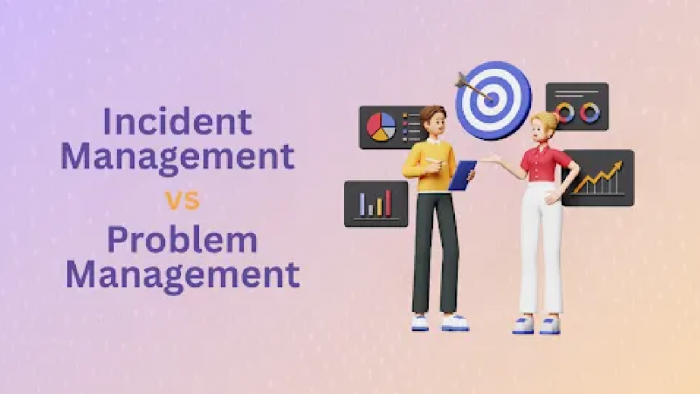Table of Content
When organizations aim to provide reliable IT services, two essential practices often come into play: incident management and problem management. At first glance, they might sound similar, but in reality, they serve distinct purposes within IT service management (ITSM). Knowing the difference between them is crucial for improving service quality, reducing downtime, and ensuring long-term business continuity. Let’s dive deeper and explore how these two processes differ, overlap, and complement each other.
Defining Incident Management
Incident management is all about quick action. An incident is any unplanned disruption or reduction in the quality of an IT service. For example, when a company’s email server goes down or when users can’t log into a platform, that’s an incident. The goal of incident management is not to find the root cause immediately but to restore service as quickly as possible. Think of it like a first-aid kit – its main function is to stop the bleeding, stabilize the situation, and get the system back on its feet.
In practice, incident management relies on a clear process of logging, categorizing, prioritizing, and resolving incidents. A well-structured incident management workflow ensures that the right team addresses the issue within an acceptable timeframe, minimizing business impact.
Defining Problem Management
Problem management, on the other hand, takes a more strategic approach. A problem is the underlying cause of one or more incidents. Unlike incident management, the goal here is not just to put out the fire but to prevent the fire from happening again. It’s about identifying root causes, analyzing patterns, and implementing long-term fixes.
Problem management often includes activities such as root cause analysis, creating known error records, and recommending permanent solutions. While incident management is reactive by nature, problem management is proactive. It aims to reduce recurring issues and enhance service stability over time.
Key Differences Between Incident and Problem Management
To put it simply, incident management deals with symptoms, while problem management addresses the disease. Below is a table that highlights their core distinctions:
| Aspect | Incident Management | Problem Management |
| Primary Goal | Restore service quickly | Identify and eliminate root causes |
| Nature | Reactive | Proactive and investigative |
| Timeframe | Short-term fix | Long-term solution |
| Example | Restarting a crashed server | Investigating why the server keeps crashing |
| Focus | User impact and service availability | Reducing recurrence and system resilience |
This distinction shows why organizations need both processes to achieve effective IT service delivery. One ensures continuity in the moment, while the other safeguards future operations.
How the Two Processes Work Together
Although incident management and problem management serve different purposes, they are closely connected. For instance, an incident may trigger a problem investigation if it recurs frequently or has a significant impact. Similarly, solutions found through problem management can improve incident resolution times by providing ready-made fixes.
Think of them as two sides of the same coin: one handles urgent emergencies, while the other strengthens the system to prevent repeat crises. Without this collaboration, organizations risk getting stuck in a cycle of constant firefighting without ever addressing the underlying issues.
Why Both Are Critical for Business Success
Downtime is expensive. Every minute of service disruption can lead to lost revenue, reduced productivity, and customer dissatisfaction. Incident management ensures that downtime is minimized, keeping businesses running smoothly. Meanwhile, problem management saves money and resources in the long run by reducing repeated issues and building a more stable IT environment.
Together, these practices enhance customer trust, improve employee efficiency, and help IT teams shift from reactive firefighting to strategic planning. That’s why many organizations integrate both into their ITSM framework, often using dedicated tools like Alloy Software to streamline workflows and gain better visibility into incidents and problems.
Practical Examples in Real-Life Scenarios
To better understand the application of these processes, consider these scenarios:
- Incident Management in Action: A user reports that their email is not working. The IT helpdesk quickly resets the user’s mailbox settings, restoring access within minutes. The incident is resolved, but the reason for the failure remains unknown.
- Problem Management in Action: The IT team notices that email failures have occurred several times in the last month. They investigate further, discover that a misconfigured mail server causes these issues, and implement a permanent fix to stop it from recurring.
These examples highlight how incident management delivers immediate relief while problem management focuses on long-term resilience.
Best Practices for Implementing Both
To get the most out of incident and problem management, organizations should follow a few best practices:
- Clearly define roles and responsibilities for both processes.
- Use automation tools to log and track incidents efficiently.
- Maintain a knowledge base of known errors and solutions.
- Encourage collaboration between service desk teams and problem analysts.
- Continuously review metrics to identify trends and improvement opportunities.
By blending these practices, companies can ensure not only rapid recovery during service disruptions but also sustained improvement in their IT infrastructure.
Incident management and problem management are not competing approaches but complementary pillars of IT service management. One restores order quickly, the other ensures stability in the long run. By integrating both, organizations can achieve a balanced strategy that minimizes downtime, improves customer experience, and builds a stronger digital foundation for future growth.


